Shevlin Sebastian's Blog, page 49
October 30, 2018
Stepping On The Accelerator
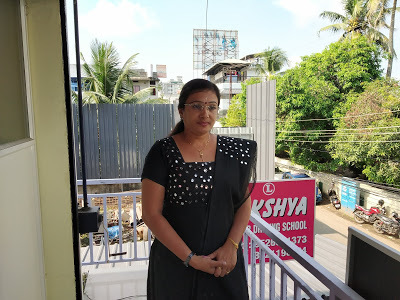
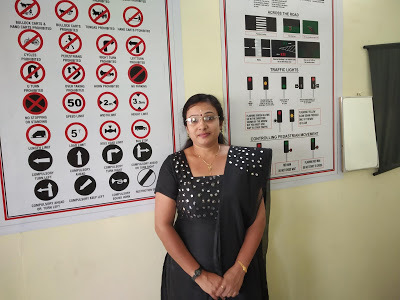
Lekha Rajendran’s life turned topsy-turvy when her husband died in an accident. But the mother of one refused to be cowed down. Today, she runs her own driving school at Kochi
By Shevlin Sebastian
At 6.30 a.m. on a recent day, Lekha Rajendran was sitting in the passenger seat of an Estilo as it moved through Kadavanthra, Kochi. In the driver’s seat was a 20-year-old girl who was staring intently at the road. Lekha asked the girl to change into second gear. The girl did so but took her leg off the clutch a bit too soon and the car jerked a bit before she managed to get it right.
Lekha runs the Leshya Driving School in Kochi. If somebody had told her a few years ago that she would be owning a driving school, she would have called that person mad.
But Lekha’s life changed irrevocably on April 1, 2013. At 11 p.m., she received a call on her mobile phone at her home in Salem. The caller said, “Your husband met with an accident near the railway gate. We are taking him to the government hospital.”
Along with her son Hariharan, who was an engineering student, Lekha rushed to the hospital.
When they reached there, Lekha saw that her husband Rajendran was lying unattended on the floor next to a door. “They had not even administered first aid,” she says. “I shouted and protested.”
So, the nurses hurriedly took Rajendran into the ward and the blood stains were wiped away. But by this time, Rajendran began vomiting. So Lekha took him to a private hospital, where he was admitted into the Intensive Care Unit.
Earlier, while talking to the bystanders, she was able to piece together what had happened. Rajendran was travelling helmetless on a Suzuki bike on the main road. Suddenly, a young man on another bike raced from a side road and hit Rajendran.
“My husband fell to the side of the road, but a pointed stone entered his neck,” says Lekha.
Anyway, Rajendran remained in the hospital for 17 days. “He was breathing but did not open his eyes even once,” says Lekha. “Eventually, my husband passed away.”
Lekha went into shock. “I could not understand what had happened,” she says. “For a long time, I found his death difficult to accept. When I would read about accidents in the newspaper, I would think that this happened to other people and not us.”
Meanwhile, the hospital bill came to a large amount. Rajendran, who was working as a contractor for the Railways, did not have much savings. So the burden to clear the debt fell on Lekha. She returned to Kerala, she belongs to Vaikom, and thanks to a friend, Sreevarma, she joined a pharmaceuticals company at Kochi as a medical representative. Her son remained at the hostel of the Thiagarajar College of Engineering at Madurai.
For the next three years, Lekha travelled on a scooter to places like Kottayam and Ettumanoor. “I enjoyed the work but had to stop because I developed back pain,” she says. “The doctor told me to stop using a two-wheeler.”
So, Lekha, after securing a driving license for four-wheelers, became an instructor in a driving school in end-2014. “I love driving,” she says. “I enjoy the control and the confidence that I feel whenever I sit behind the wheel. I also enjoy teaching.”
After two years, Lekha felt the desire to become independent. So, on November 13, 2017, she started her own school.
Today, Lekha has become a different person altogether. “It has been a tremendous change for me,” she says. “During my twenty-year marriage, I hardly ever stepped out of the house. I was a frog in the well. Now I have become outgoing and confident, although it took a tragedy for me to become a new person.”
This confidence has enabled her to tackle some of the negative experiences that she has faced. “When people come to know that I am a widow, they get different ideas,” says the 43-year-old. “And that is difficult to bear. Initially, they come with the idea of wanting to help, but later, they reveal their actual motive of wanting to get friendly with me.”
Meanwhile, she is proud of her son, who has a job at Kochi and is doing his M.Tech in SRM College at Chennai. He goes on weekends to attend the classes while he is also doing his MBA, through distance education, from Pondicherry University.
The driving lesson came to an end. The girl got out of the car. And so did Lekha. She went back to her office. Life goes on. But this woman, unlike many others, has refused to succumb to depression and passivity and has turned her life around.
A quiet heroine of our times!
(The New Indian Express, Kochi, Thiruvananthapuram and Kozhikode)
Published on October 30, 2018 23:03
October 29, 2018
Triggering An Inner Healing
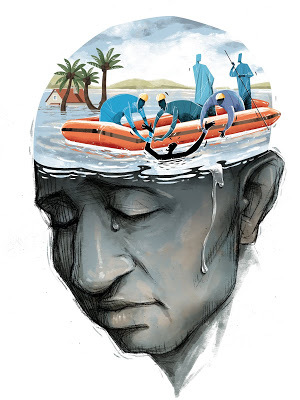
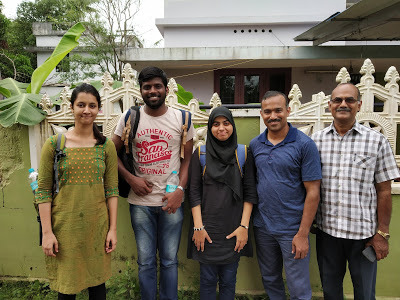
A group of trained volunteers from Pune, along with local NGOs spent a month in Eloor trying to help flood victims overcome their emotional trauma
Illustration by Amit Bandre; (from left): Jahnavi Iyenger, Dnyaneshwar Ghuge, Seeba Bhojwani, Bobby Zacharia and KK Sunil
By Shevlin Sebastian
Lakshmi is standing at the door of her house at Eloor wearing a white saree, matching the white of her hair. The Periyar river is less than ten feet away. But on this day, it flows gently and calmly. It has been a few weeks since the river water rose and submerged her house. But the 80-year-old managed to escape, thanks to alert fishermen, on a boat towards a school which was set on higher ground.
It is a small house: a bedroom, kitchen and a bathroom at the side. “That is all that I need,” she says. “My husband abandoned me forty years ago. He has another wife and family now. I brought up four children -- three sons and a daughter -- on my own. They are all married. Now only one son bothers to look me up.”
Asked whether she is scared about the future, she says, “What will happen will happen. If you want to die, can you do so? Only God can decide that.”
Listening to her intently is a group of people. They include Seeba Bhojani, Dnyaneshwar Ghuge, and Bobby Zacharia, trained volunteers who have come all the way from Pune along with their youngest colleague Jahnavi Iyengar. She has just passed her Class 12 exams and is on a gap year. With them is KK Sunil of the Kochi-based NGO Chaithram, a suicide-prevention group. The Pune members are part of the group HiCup -- ‘Hope, Change, Prosper’, which had been set up by Seeba. They have partnered with a Pune NGO Jnana Prabodhini and Maithri, a suicide-prevention NGO in Kochi.
The Pune team had read about the floods in the newspapers. They felt a need to contribute. “I knew from my own experience that after a major disaster, the most neglected aspect is the emotional damage,” says Seeba. “People have lost their earnings, belongings and homes, and even their loved ones. That is very traumatic. I felt we should listen to their problems, and help in their psychological recovery.”
The Eloor Municipality was the most affected. Nearly all the houses went under water. After talking to the municipality chairman, they decided to focus on wards 1, 2 and 31. Overall, they visited 400 houses. And for some houses, they made three visits spread over a month.
After the initial effort to get their houses cleaned, the people were faced with the problem of earning a living. Most of them were farmers, some were carpenters while a few were mechanics. “There was one man who was running a workshop,” says Seeba. “But the welding equipment got damaged. And he cannot use it again. Now he does not have the money to invest in a new one.”
A tailor’s sewing machine was damaged in the floods. The woman repaired it but the people who are giving her clothes to stitch do not have enough money to pay the appropriate amount. “So, she cannot earn a decent income,” says Jahnavi. In another case, a family had 30 sheep and all had died. Unfortunately, the animals were not insured.
Meanwhile, the stress is getting to people. Alcoholic consumption has increased. “Many men are running away from reality by drinking,” says Bobby. “Unfortunately, some of them, when they get drunk, end up beating their wives.”
Children have also suffered. “Many felt neglected,” says Bobby. “Their parents were focused on the work of getting their house back to normal.”
The children have gone through their own trauma of losing their favourite books, textbooks or a precious toy. Many had chickens, parrots, cats and goats as pets. “They were emotionally attached to these animals,” says Bobby. “So when they died, the children felt sad.”
As for the teenagers, a few felt angry and rebellious. “Earlier, they would listen to their parents, but post-flood, they don’t,” says Sunil. “They prefer to go out with their friends. When we talked to one boy, who is in Class 11, he said that this is the only way he can get some mental relief. He had lost his books, a computer table, and his beloved keyboard. He told us he had no one to share his sorrows, except with his friends.”
There are health breakdowns, too. “Many are diabetic and have heart problems,” says Dnyaneshwar. “Most government medical centres in the area had shut down because of the floods. So the people could not get their regular medicines. One woman was going through a fertility treatment and could not take medicines for a month. So her problems have resumed.”
But some people have found simple ways to combat stress. One lady had a hen which had laid four eggs. And they have all become small chicks. When she feels depressed, she goes to the courtyard and spends time in front of the chicks as they run around. “She feels happy,” says Seeba. “Another woman, when she was cleaning her house, saw a small fish swimming in the water. She picked it up and put it in a bowl. Now she keeps staring at the fish. She says that this enables her to destress.”
Interestingly, no one is angry with God about what had happened. “On the other hand, they are thankful that God had saved their houses and families,” says Sunil. “They know that in places like Idukki, several houses were swept away in the floods. And so many lives were lost. One woman said, ‘I am very grateful to God that he spared us’. They have become more spiritual and pray a lot now. They no longer take anything for granted.”
But the road to recovery is long and arduous. While the Pune group will be returning soon, Sunil said that they would continue to provide emotional support for at least six months, to ensure that there is some form of psychological healing. “We are hoping for the best,” he says.
(The New Indian Express, Kochi, Thiruvananthapuram and Kozhikode)
Published on October 29, 2018 00:13
October 27, 2018
The Beauty Of Art
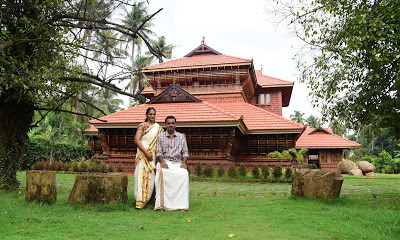
The Neelambari resort at Arattupuzha, Kerala focuses on traditional classical dance forms
Photo: TS Sreeni and his wife Meera. Photo by Albin Mathew
By Shevlin Sebastian
Revital Eytan, senior lecturer and a director in the School of Performing Arts at the Kibbutzim College of Education, Tel-Aviv, was in Kochi recently. She wanted to do research on the performing arts of South India. As she moved around, somebody told her that the best place to witness authentic classical dance performances was at the Neelambari Ecotourism resort at Arattupuzha (80 kms from Kochi). So she decided to go for a day.
Managing Partner TS Sreeni arranged for Revital to see a koodiyattam dance. But to ensure that Revital understood what she was seeing, Sreeni quickly briefed her on the social and historical context. After the performance, she asked the dancer whether she could learn from him. The end result: Revital stayed for eight days.
The Neelambari is a resort with a difference. “The idea is to showcase the rich cultural legacy of Kerala,” says Sreeni. So, the resort has a Koothambalam (a sort of temple theatre). Inside the hall, there are four intricately carved pillars. The ceiling is also etched with fine designs. The wooden stage floor gleams. The backdrop is a wooden wall. The audience sits on cane chairs, as a cool breeze blows in through the trellised windows.
And it is in this hall that visitors can see a Kathakali dance as well as Thayambaka (drums), and Tolpava Koothu (puppetry) performances. Interestingly, there are no in-house artists. Instead, Sreeni calls them to the resort or takes the visitors to dance centres nearby. Noted Koodiyattam exponent Usha Nangiar has a dance school just three kilometres away. Usha shows the movements in slow motion and explains the symbolism. “It is very enchanting for the guests,” says Sreeni.
Incidentally, the design of the main building at Neelambari is in traditional nalukettu-style (this is a rectangular structure where four halls are joined together with a central courtyard which is open to the sky). Mural paintings adorn the walls. The roof is made of red tiles. This area comprises the reception and the lounge. Nearby, there are cottages of two rooms each. The furniture, the doors and windows are wooden; everything is spic and span. The ambience is rural. There are no sounds except of birds and insects. Mentally, you tend to slow down and feel calm.
For those who are not interested in the arts, there are yoga classes, Ayurveda massage, the use of a spa, a boat trip down the nearby Karuvannur river, apart from visits to nearby temples and villages.
And it is interesting to know that Sreeni has given up a thriving career in the IT business. After passing out of the Indian Institute of Technology at Kanpur in 1998, he had worked in Wipro before joining Kalkitech, an IT company in Bangalore. In 2016, when he quit, he had been vice-president of international sales at Dubai. “I wanted to try something different,” he says. “Initially, my plan was to write a novel.”
But a chance meeting with a friend, who is an affluent businessman based in Dubai, was a turning point. The latter agreed to invest in Neelambari as an art centre.
Art has always been close to Sreeni. “I grew up in a cultural ambience at Chalakudy,” he says. “There was a Kathakali Club in our area. When I grew older, I read a lot of books on traditional dance forms and kept attending programmes.” But while in Dubai, Sreeni joined a group that conducted the prestigious International Koodiyattam and Kathakali Festival. “I was able to make a lot of contacts with artists,” he says. “My interest deepened and this eventually resulted in the Neelambari.”
Published on October 27, 2018 19:51
October 26, 2018
“This Award Is A Boost For Regional Writers”
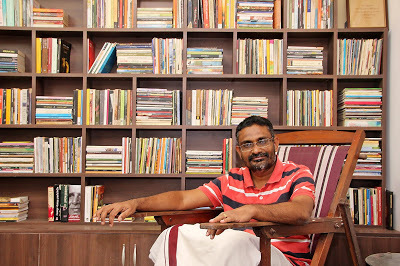
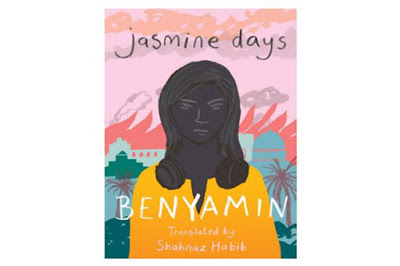
Says author Benyamin after winning the inaugural JCB Prize for Literature (Rs 25 lakh) for his novel ‘Jasmine Days’
Photo of Benyamin by Albin Mathew
By Shevlin Sebastian
When it was announced that Benyamin had won the inaugural Rs 25 lakh JCB Prize For Literature for his novel, ‘Jasmine Days’ at a function in New Delhi, on October 24, he felt an overwhelming excitement. “I also felt surprised I had won even though I was on the shortlist,” he says.
The other books included ‘Poonachi: Or The Story of a Black Goat’ by Perumal Murugan, ‘Latitudes of Longing’ by Shubhangi Swarup, ‘Half The Night Is Gone’ by Amitabha Bagchi, and ‘All the Lives We Never Lived’ by Anuradha Roy. Not surprisingly when he went on stage, he said, “This is the most beautiful evening of my life.”
After the function, author Arshia Sattar told Benyamin, “From the time of the publication of ‘Goat Days’ [Benyamin’s best-selling novel], I felt you deserved a big award, so I am happy you finally got it.” A smiling Benyamin said, “It was a happy moment for me when she said that.”
Benyamin was also happy that a regional language novel was able to win this prestigious award. “Too many people abroad believe that Indian literature means Indian-English literature,” he said. “But my win has shown that there is very good work being done in the regional languages. I believe this will prove a boost for regional writers. People have the mistaken impression that we are not that good and do not communicate to a larger world.”
The novel, (translated into English by the New York-based teacher Shahnaz Habib), focuses on the life of radio jockey Sameera Parveen from Pakistan and how her life changes when a revolution comes to an unnamed West Asia country. The events described are similar to what took place in different countries of West Asia, following the Arab Spring of 2010.
“I lived in Manama (Bahrain) for over 20 years, so I had some knowledge of the area,” he said. “In Bahrain, people protested at the Central Square asking for democracy but in the end, it failed. So I thought I would write a novel about it.”
All these conflicts, as well as a rising fanaticism all over the world, is worrying Benyamin. “The power of religion is growing day by day,” he said. “Neighbours are becoming enemies. People are losing their tolerance and compassion. People say, ‘My religion and my belief are the right ones. Any other religion and thought processes are wrong’.”
The spread of technology is accelerating the divide. “In earlier times, if a person spouted hatred it was limited to a certain area,” he says. “Now, thanks to Facebook, Whatsapp and other apps, a man’s verbal poison can travel the entire world and infect so many people. In fact, sadly, too many people are spreading poison all the time. I fear for the future of societies when there is so much of hatred all around.”
Meanwhile, when asked whether there is a market for literary fiction, Benyamin says, “In every civilisation reading has not been a major pastime. In fact, it is a small minority that reads books, especially literary works. But I believe that, thanks to rising education levels, the number of readers has steadily increased, especially in Malayalam literature.”
(The New Indian Express, Kerala editions)
Published on October 26, 2018 22:52
October 19, 2018
A Drug Bust, Revisited

Former Australian diplomat Brian Milgate entangled with drug smugglers at Kochi in 1983 and went through harrowing experiences. After writing a screenplay, he had recently come to Kochi with an idea of making a bilingual film By Shevlin Sebastian
In January, 1983, sailor Brian Milgate set sail from Darwin, Australia, accompanied by his girlfriend Alison McGuinness, to take part in a transatlantic yacht race from Britain.
However, near the coast of Sri Lanka, the rudder of his yacht ‘Tiger Rag’ got entangled with a fishing net. He pushed on, but a sudden storm made it difficult. Since he was near Kochi, he stopped near the Bolgatty Palace for repairs. Soon, he befriended a fellow Australian named James Howard, who had been living at the Palace for a year with his girlfriend Jyl Gocher. A retired photojournalist, James told Brian he was going to England for a medical check-up and would bring back spare parts for his yacht. But, in return, Brian should supervise the repairs which were taking place on his own boat ‘Steppenwolf’. Brian agreed. Soon, James left. As Brian began working on the ‘Steppenwolf’, he became suspicious. “There were sophisticated electronic equipment, a powerful transmitter, a satellite-linked navigator, computers and dark-room equipment,” says Brian, while on a recent visit to Kochi where he stayed at the Bolgatty Palace. And James did not return by plane. Instead, he came on a ship called the ‘Hetty’ in March and was accompanied by a man called Richard Merkley. The latter was known in drug enforcement circles as a narcotics trafficker. Brian aired his suspicions to the Customs at Kochi. They raided the ship but did not find anything incriminating. James was incensed. He hired a couple of men to kill Brian, but the latter managed to escape. Brian then spoke to Maxwell Fernandes, a reporter of the Indian Express who published the story. It created a furore. James filed a defamation suit against Brian, who had to hire a lawyer to defend himself In the end, Brian managed to return to Perth along with Allison. Thereafter, he did intensive research and sent letters regarding his suspicions about the ‘Hetty’ to the drug enforcement agencies in London and Washington. Meanwhile, the ‘Hetty’ set sail from Kochi. And sometime in November, when it appeared near the coast of New Jersey, the US Coast Guard intercepted it. A search was done. Below a cargo of timber, there were 13 tonnes of hashish in the form of bricks. It was worth $200 million and was one of the biggest international drug hauls ever.
“I was told that because of this interception, the Mafia in America lost $75 million which they had paid as an advance for the consignment,” says Brian. “But even though there was a suspicion that the hashish had been put into the ship at Kochi, nothing could be proved. So James could not be apprehended.” Anyway, back in Perth, to overcomes the stress and tensions of the past several months, Brian and Alison wrote a book. This was published as ‘The Cochin Connection -- Two against the drug trade: a true story’ which became a bestseller. Soon, many Hollywood studios expressed an interest in making a film. Five screenplays were written. But Brian was not satisfied by any one. So, no film was made. In the meantime, a qualified Naval architect, Brian concentrated on his career as a trade diplomat in the Australian government. “I worked on two trade missions to Japan to make environmental changes in industry,” he says. Brian also wrote the national policy on water because he was the team leader on the Economic Water Resources Model. Thereafter, tired of dealing with politicians, Brian left the government and started the Lemon Myrtle Farms. “It is an organic farm,” he says. “We have 1.2 million trees. Lemon Myrtle is an Australian native tree. We make oil, tea and food flavouring.” These are exported to Germany, England. Singapore and Malaysia. But after 25 years of running the farm, Brian sold it two years ago. “Now I am retired,” he says. “And I am travelling the world on my yacht and having a good time.”
As for his personal life, he married Allison and divorced her after 10 years. Thereafter, for ten years, he remained single, before he married a Chinese doctor who lives in Australia. Then, in January, this year, he, along with his wife, had gone to the latter’s home in Chengdu, China. She wanted to look after her 87-year-old father who was ailing. That was when Brian got the idea to write the screenplay of 'The Cochin Connection' himself. “It took me two months,” he says.
Brian had come to Kochi to meet Mollywood producers who would be interested in making a film. “It will be a bilingual production, in Malayalam and English,” he says. “Talks are going on.”
Meanwhile, most of the dramatis personae are no longer there. James died of cancer, at the age of 67, in 1987. James’s girlfriend Jyl took his money and bought an apartment in Singapore. “I am told she is living there comfortably,” says Brian.
Maxwell died in 1985 at the age of 46. “He had been threatened by James and the stress and trauma of the episode may have led to his premature death”, says his Kochi-based uncle Edgar Morris, who is helping Brian in connecting with prospective Mollywood producers. “I remember that whenever I walked with him on the streets, he would constantly look back.”
(The New Indian Express, Kochi, Thiruvananthapuram and Kozhikode)
Published on October 19, 2018 23:30
October 15, 2018
Australian Couple To Hold Fund-Raising Dinner In Queensland For Kerala Flood Victims
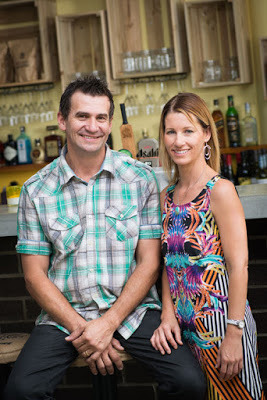
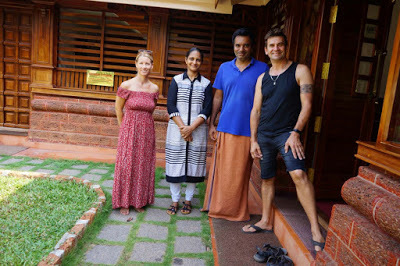
Photos: Antonio (Tex) and Kellie Teixeira; (from left) Kellie, Meera, TS Sreeni and Tex
By Shevlin Sebastian
In May, this year, Australian restaurant owners Antonio (Tex) and Kellie Teixeira came to Kerala with their family to enjoy the Thrissur Pooram. They stayed at the Neelambari resort at Arattupuzha (15 kms from Thrissur). The resort owner TS Sreeni was much taken up by the fact that the couple had adopted three children.
“The girl Mkhaya was from Ethiopia, the elder boy, Locklyn is of Philippines origin, while the younger boy Jun Yung is from Vietnam,” says Sreeni.
Soon, a friendship developed between the Teixeiras and Sreeni and his wife Meera. Says Tex, “Sreeni and Meera cared for us so much.” So, it was no surprise that when they heard that the resort had gone under six feet of water, following the Kerala floods, the Teixeiras offered to send some financial assistance.
“I replied that I could manage, but they could help many of the poor people whose houses had been washed away,” says Sreeni. But he did not hear from them for a while. Then on Thursday (October 11), he got a Whatsapp message from them.
Tex and Kellie are holding a fund-raising dinner on October 23 at their ‘Lemon and Thyme’ restaurant at Queensland for the villagers of Arattupuzha. It is titled, ‘From our village to yours charity dinner’. The meal is priced at 50 Australian dollars.
The menu is Indian. So, the entrée item consists of vegetable pakoras, beef and vegetable samosas, with spiced mango chutney. In the main meal, there is a choice of North Indian lamb and potato curry, butter chicken, and coconut pumpkin pie. All meals will be served with rice, chutney and naan.
“As for the dessert, it will be banana fritters with sweet yoghurt, saffron and pistachios,” says Kellie.
She pauses and says, “We are expecting a very good response.”
Sreeni smiles and says, “Their heart is in the right place.”
(The New Indian Express, Page 1, all Kerala editions)
Published on October 15, 2018 23:07
October 14, 2018
“Emotional Recovery Will Take Time”
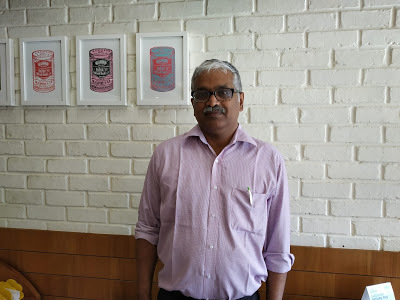
Says the UK-based psychiatrist Dr PJ Saju as he conducts a workshop for counsellors at Kochi to help them as they work with the survivors of the Kerala floods
By Shevlin Sebastian
“The good news is that most people, despite going through a devastation like the recent floods in Kerala are highly resilient,” says Dr P. J. Saju, a Malayali psychiatrist based in Leeds, United Kingdom. He had come recently to Kochi to conduct a one-day workshop titled, ‘Overcoming trauma through courage and compassion -- creating better worlds’ which was organised by the NGO Bodhini. The participants included psychologists, counsellors, psychiatrists and teachers who are working with the survivors.
“They may appear helpless,” says Saju. “But it is very important that when you deal with them you should regard them not as a victim, but a survivor. Your task is to rekindle the strengths which have been affected by the trauma.”
Interestingly, more than the men, it is the women and children who feel the stress more. “The women usually suffer from Post Traumatic Stress Disorder (PTSD) because they are dealing with the family all the time. It also depends on the extent of the damage. What has been the loss? If they have lost their livelihood, jobs, house and property, they are under more stress.”
As for the children, most of the time, adults do not spare any time to listen to them. They may have lost a pet, a favourite study table or their story-books, and these are very dear and important to them. “The effect is far more than we can imagine,” says Saju. “Teachers can have a good impact by listening attentively. Their painful loss has to be acknowledged. If children are not given an opportunity to grieve, they will shut down. There has to be some activity where they can express their feelings of loss and grief.”
And Saju urged the counsellors to settle in for the long haul. “You have to work with the survivors from one to three years,” he says. “Especially for those who have lost their family members. They have to come to terms with their loss. Calm talk, calm actions and calm explanations will help.”
According to Saju, around 30 per cent of the affected people will have severe emotional problems that will prevent their return to normalcy. “Of that number, about 10 per cent may suffer from severe PTSD,” he says. “Some of them may feel suicidal. The remaining 20 per cent may suffer from depression. So they have to be helped with plenty of psycho-social assistance.”
But Kerala has a few in-built advantages. “Our extensive family network can be very helpful,” says Saju. “Survivors can talk it over with their relatives. For those who have strong religious beliefs, if they take part in rituals at a church, temple or mosque, that can have a healing effect. Having a talk with a priest, pujari or an imam is also helpful. This enables them to express their sorrow and get over it. Our social capital, as compared to Western countries is our greatest asset.”
Saju says that going through a trauma does not necessarily inflict a lifelong psychological scar. “It might bring out the best in people,” he says. “They might become better human beings and value life more. Some might discover hidden strengths. For example, people may try a new business which might be successful. In Western psychology, this is called a post-traumatic growth.”
Saju also told the participants that they could go through a difficult time even as they are helping the survivors. “That is because your compassion is awakened,” he says. “So, you will also be affected by all the stories you hear. Hence, you will have to find ways to shield yourself: go for regular exercises, spend time with the family, see a film, or an art exhibition, listen to music or do some reading, and visit a place of worship, all this can help.”
Personal life
Saju grew up in Kochi. He did his graduation from Sacred Heart College, Thevara then completed his MBBS from Calicut Medical College in 1990. Thereafter, Saju went to CMC College in Vellore where he got his MD in psychiatric training and worked there for six years. In 1997 he went to the UK.
Today, he runs a transgender clinic at Leeds city as well as a cognitive behavioural therapy clinic at a place called Wakefield.
Interestingly, he says, over the years, Britain has changed a lot. Earlier, they were known for their stiff upper lip but now the people are more revealing of their emotions. “The change occurred when Princess Diana died in a car accident in 1997 and there was a public outpouring of grief,” says Saju. Also, multiculturalism is playing its role. As the Britons live with people from different cultures and nationalities, they are beginning to shed their reserve.
Meanwhile, as he grows older, Saju feels the need to get back to his roots. “I come at least twice a year to see my mother who lives in Kochi and also to meet up with my friends and relatives,” he says. “So I am very happy that on this trip I was able to pass on my knowledge to all those who are in the forefront of helping the survivors of the devastating floods.”
(Published in The New Indian Express, Kochi, Thiruvananthapuram and Kozhikode)
Published on October 14, 2018 23:47
October 9, 2018
A Whiff Of Paradise
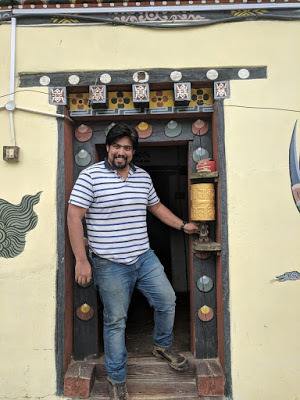
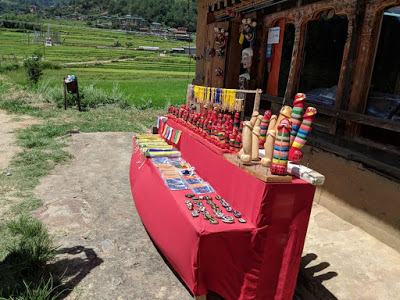
The Kochi based travel entrepreneur Tharun Anto talks about his experiences driving in and around Bhutan
By Shevlin Sebastian
Pics: Tharun Anto; phalluses on display
The moment the Kochi-based travel entrepreneur Tharun Anto crossed from Jaigaon on the Indian border to Phuntsholing, the entry point to Bhutan, the difference was like night and day. “In Jaigaon, it was noisy, dusty, dirty and overcrowded,” he says. “But in Phuntsholing, it was spotlessly clean, sparsely populated, and there was very little dust.” His local guide, Ugyen Phuntsho hopped into Tharun's Renault Duster at the border town.
Tharun had decided to go to Bhutan because it is the only country which measures its prosperity by Gross National Happiness, whereas all the other countries measure it by Gross Domestic Product. “I wanted to find out whether the people were actually happy,” he says.
His initial impressions were positive. There were numerous trees lining the two-lane highway. And it is a country that abounds in nature. “In fact, in Bhutan, there is a constitutional law which states that 70 per cent of the country should always be under forest cover,” says Tharun. “However, this is not very difficult because it has a population of only eight lakh people.” (Incidentally, it has the same geographical area as Kerala, but the state has a population of 3.9 crore).
Soon, Tharun was off to see one of the most popular tourist sites in Bhutan: the Tiger’s Nest at Paro (10,000 feet above sea level), which was built in 1692. This is a sacred site for the Buddhists.
According to historical records, in the eighth century, Guru Padmasambhava, who introduced Buddhism to Bhutan, meditated for three years, three months, three weeks, three days and three hours. There are thirteen taktsangs or ‘tiger lair’ caves in which he meditated. “To reach the top is a two-hour trek,” says Tharun. “But it is worth it because the view from the top is awesome.”
Another place to visit is the Dochula Pass, which is on the road from Thimpu to Punakha where 108 memorial chortens or stupas have been built by Ashi Dorji Wangmo Wangchuk, the eldest Queen Mother. These were made in honour of the Bhutanese soldiers who died in a battle against Assamese insurgents in December, 2003. Apart from this, there is also a Royal Botanical Park.
It was while travelling around that Tharun noticed that the male phallus was painted in nearly all government and private buildings. “The phallus is regarded as a sign of prosperity,” says Tharun. “It is also a protection against evil. In one monastery where I went the monks blessed me by touching a large phallus against my head, the way Christian priests use the Crucifix.” There were many phallus souvenirs on sale for tourists.
He also liked the houses, many of which were made of stone, cement and wood. “I was told that wood absorbs a lot of heat,” he says. “So, it is good to stay in a wooden house in winter.”
In fact, Tharun did stay at a wooden home at Punakha, which belonged to a woman called Aum Dajozam. She had worked in the tourism industry at Thimpu (85 kms away) for four years and had to leave her job to look after some land she had inherited at Punakha. Her husband gave her the idea of allowing tourists to stay at their home.
Tharun stayed in a room of only 125 sq. ft., on the first floor. “The rooms are small because the Bhutanese are small people,” says Tharun. The average height is 5’4” for the men and 5’ for the women.
“The room was pleasant,” says Tharun. “There was no need for a fan. The temperature was 24 degrees centigrade and there was little humidity.”
He also took the opportunity to partake of the local food. Ema datsi is the national dish. It is a cheese curry, which has large green chilli peppers and potatoes.
Mostly, the Bhutanese eat a lot of beef and pork, to feel warm. In a place called Bumthang, in central Bhutan Tharun ate bread using the local butter, which was far less salty than those found in India, along with honey. He also had an ara, which is a rice wine and has an alcohol content of 14 to 18 per cent. “You can get high very fast,” he says, with a smile.
Finally, when asked whether the Bhutanese people were happy, Tharun replied in the affirmative. “They are kind, helpful and serene,” he says. Asked the reason behind their happiness, Tharun says, “From childhood, they are trained to think of death at least five times a day. When you think of death so often, you learn to appreciate whatever you have.”
(Published in The New Indian Express, Kochi, Thiruvanathapuram and Kozhikode)
Published on October 09, 2018 22:15
October 8, 2018
Flavours To Melt Your Heart
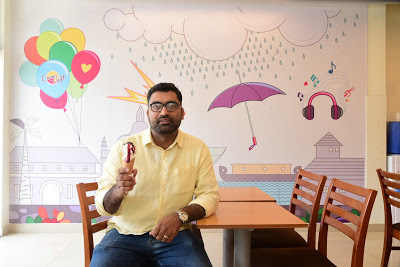

Former IT professional Samir Joseph went to study gelato-making at the Carpigiani-Gelato University in Italy. Today, he runs Cream Craft in Kochi, which is steadily growing in popularity
Photos: Samir Joseph; Heavenly Hazelnut ice cream. Pics by Albin Mathew
By Shevlin Sebastian
When Samir Joseph stepped into a classroom at the Carpigiani-Gelato University at Bologna (375 km from Rome), in October, last year, the first thing he noticed was a large logo of Carpigiani in blue pasted across one wall. At the far end of the room, besides a white board, there were large images of gelato ice cream. Carpigiani is one of the largest companies in the world that manufactures gelato-making equipment, like batch freezers and pasteurisers.
As he sat on a chair with an attached desk, Samir immediately began to hear different accents. Later, he came to know that the 40 students came from countries as varied as the USA, Canada, Britain, Iceland, France, Australia, Sri Lanka, China and India.
During the morning hours, he studied subjects like what constitutes a gelato mix, the different type of ingredients and recipes, the design of a store and the cafe business models. After 3 p.m., it was practical classes supervised by an instructor and two assistants. Incidentally, Samir was accompanied by his cousin and business partner Josemon Mathew.
Among the crowd, Samir was one among a very few who came from the IT industry. Having worked in blue-chip companies like Wipro and Tech Mahindra, Samir was looking for a change in career. “I began to feel restless,” he says.
Asked why he decided to focus on ice-creams, he says, “Ice-cream is not so much about creativity but it is a science – of getting the right mix. And since I have an engineering background, [from Pune University], I felt that this would be suitable for me.”
Some of the other things he learnt at the university was that while regular ice cream is stored at -18 degrees centigrade, for gelato it is -14 degrees centigrade. “Texturally, gelato is very different,” he says. “It is smoother and creamier.”
Regarding the difference between icecreams and gelato, on the university website, with a touch of humour, it is stated, 'Gelato contains less fat than ice cream, has less incorporated air and is served at a higher temperature. Consequently, gelato provides a greater flavourful experience because there is less fat that coats the tongue, more flavour per spoonful, and the taste buds are more alive since the temperature is not so cold as to dull their sensitivity.”
It was only a week-long course, but Samir was confident enough to return and start his own gelato outlet called Cream Craft in Kochi a few weeks ago in a partnership with his entrepreneur cousins Shaju, Sunny, Shibu and Josemon. He has imported a batch and display freezer, as well as a pasteuriser from the Italian company.
And right from the beginning, Samir has been doing a lot of experimentation.
“I have made gelato using the spices of biriyani,” he says. He has also made flavours using popcorn, doughnut, rasmalai, and carrot halwa.
It has been well received. Says patron Nizzwa: “There are all kinds of flavours.. from laddu to blueberry cheesecake! Don't get attached to any flavour because they keep changing it every day.”
Adds another customer Joe Alex: “The flavours are all natural and unique.”
On a recent evening, as the 34-year-old Samir was helping out in the kitchen, making a gelato, a memory drifted into his mind. It was a Sunday afternoon in Kolkata more than two decades ago. Samir and his elder sister Sunita stood by the side of the dining table, as their father hand-mixed a cake batter. There were no beaters at that time. Their mother was adding the ingredients to the batter.
And the two children helped in their own little ways. “In those days, cakes were made in a pressure cooker because we did not have an oven,” says Samir. In the end, they made a sponge cake. “Sweets and desserts are a reminder of family love, and all of us doing something together,” he says. “Maybe, that's why I am making ice-creams now.”
Published on October 08, 2018 23:05
A Wide Palette
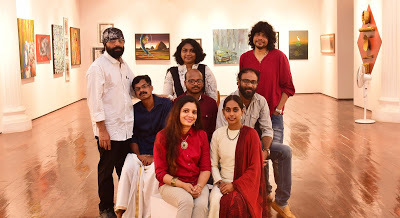
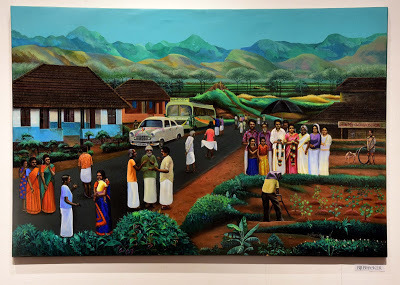
More than 50 artistes took part in the third edition of the Cochin Art Show, which was held recently
Photos: The participating artists: Standing; Curator O Sundar; Babitha Rajeev and Basanth Peringode; Second row: KG Babu, Biji Bhaskar and Manikandan Punnakkal. Fronbt row: Bindhi Rajagopal and Anju Acharya. Photo by Albin Mathew. Work by Biji Bhaskar
By Shevlin Sebastian
One morning, as dawn filtered through his bedroom window at his home in Muvattupuzha, Kerala, artist Biji Bhaskar awoke, but kept his eyes closed, as he stared at a scene in his imagination. It was a visual from his ancestral village of Pothanikad.
“In those days life was simpler, there were no walls between houses, just hedges, and the people would interact with each other a lot,” he says. “Nowadays, people live in flats in cities and have no relationship with their neighbours.”
So when he got down to work, later in the morning, he decided to recreate the image. It is a post-wedding scene. So, at one side, a newly-married couple, holding garlands in their hands, stand surrounded by relatives and friends, while somebody holds up a black umbrella, to protect the duo from the sun. Just a few feet away, a photographer, a towel over his head, is peering into a camera placed on a tripod.
This is just beside a newly-tarred road, where there is an Ambassador which has ribbons placed diagonally across its bonnet, and a large Ashok Leyland bus which has brought the guests from far away. “It is a scene from the 1980s,” he says.
This work was featured in the third edition of the Cochin Art Fair, conceptualised and created by the Kochi-based artist O Sundar. 52 prominent and upcoming artists were taking part including Anil KV.
He has done canvases of 1 x 1 ½ feet that also shows idyllic scenes. A boy and a girl are flying a kite. Another pair of boys is catching a crab, near the backwaters. One boy is climbing a tree. A couple of schoolgirls in white tops and blue skirts, as well as a boy, is going to school. But behind them, there is an ammonia plant. In the others, in the background, there is an oil tanker, a plane and an aircraft carrier.
“These scenes are from Willingdon Island,” says Anil. “I stayed there for the first 25 years of my life, as my father worked in the Cochin Port Trust. It is a dangerous place because there are ammonia factories, a sulphur factory, and 35 oil tanks. A Navy base is nearby. What I am trying to say is that at any moment there can be a major accident or fire on the island.”
In fact, a few months ago, an unmanned aerial vehicle operated by the Southern Naval Command hit an empty tank in a bulk liquid fuel terminal on the island. “There were fuel-filled tanks nearby,” says Anil. “Thankfully, a major tragedy was averted.”
Moving around the exhibits is architect A Mayukh, who is an art lover. “The versatility is amazing,” he says. “What I liked is that youngsters as well as senior artistes are sharing the same space.”
Mayukh met the curator O Sundar who told the art enthusiast, “There are no themes. People could put up what they wanted.” And so the themes ranged from nationalism, to deforestation, childhood vignettes, the impact of the Kerala floods and the isolation of unmarried people from society.
Meanwhile, artist Shinoj Choran has done a watercolour of dozens of men standing in a straight line, in bare feet, wearing a similar uniform with a cloth bag covering their heads. At one side, almost like a bookend is the Ashoka Chakra, one of the enduring symbols of Indian democracy. Not surprisingly, Shinoj has titled his work, 'Under the shadow of democracy'.
“There are many people who are getting arrested, be it Maoists, human rights activists and artists,” he says. “They are standing in a line or they could be lying down. Their heads are covered to give them the symbol of victims.”
Shinoj's works have turned political in the past couple of years. “We are steadily losing our freedom,” he says. “That is the message I want to convey.”
As for Narayanan Mohanan, he also has a message. In his striking work, done in yellow glitter, against a red background, called '(Re)Build', there is, in ascending order, a power switch, a broom, a tray for transporting a cement mix, usually carried by workers on their heads, the filter inside an air-conditioner and a strained water pot.
“All these are related to the construction of buildings,” he says. “Even if we say we belong to God's Own Country, there is lip service when it comes to protecting the greenery. Instead, construction is going on relentlessly. Politicians and bureaucrats are not protecting the environment. This is my critique of the system. Following the massive destruction caused by the floods, we need to rebuild in a different way.”
Finally, there is Kochi Biennale Founder Bose Krishnamachari's work called 'Forgetting is not as the same as not remembering'. It is a look at Indian nationalism, from the 1940s to the present day. There are eight graphite pieces, 2' by 1', placed one under the other, with sub-headings like 'Nationalism', 'We The People', 'War and Peace', 'Indira is India', 'Who am I?', 'Things Fall Apart', 'Fear and Loathing' and 'Nationalism?'
Says Bose, “The nationalism in the 1940s was very different from the right-wing nationalism of today. Will it take India back towards the dark ages? ”
A river of talent
There were also striking works by Shibhu Natesan, Babitha Rajeev, Anju Acharya, Babu Xavier, Bara Bhaskaran, Basanth Peringode, Bindhi Rajagopal, Tom Vattakuzhy, Appukuttan MB, Ashil Antony, Rimzon NN, Babu KG, Akhil Mohan, Dhanya MC and Aswathi Mohan.
Published on October 08, 2018 01:14



